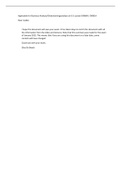Applicable for Business Analysis/Ondernemingsanalyse at K.U.Leuven D0I68A / D0I81A
Dear reader,
I hope this document will save your exam. It has taken days to enrich this document with all
the information from the slides and lectures. Note that this summary was made for the exam
of January 2023. This means that if you are using this document on a later date, some
content will have changed.
Good luck with your exam,
Elias De Boeck
, 1. BUSINESS ANALYSIS
Business analysis
Business Analysis
- Business analysis = practice of enabling change in an enterprise by
defining needs and recommending solutions that deliver value to
stakeholders
o BACCM = Business Analysis Core Concept Model
o BABOK = Business Analysis Body of Knowledge (collection
of concepts, practices,… considered as standard within a
profession)
Roles of a Business Analyst
- Business analyst : elicits, analyses, communicates and validates
requirements for changes to business processes, policies, and information systems (focus on
communicating business needs)
o Multiple roles (problem solver, facilitator, negotiator, architect, planner,
communicator, expert, strategist)
o Elicitation = focus on gathering requirements from various stakeholder groups
▪ By brainstorming, focus groups, interviewing,…
Competencies of a Business Analyst
- Business knowledge
o Business acumen = awareness and knowledge about solutions that have been
considered/ implemented in other organizations
o Business knowledge
▪ Business model and strategies (the way a company creates and delivers
value to its customers)
▪ Organizational Knowledge (internal structures)
o Industry knowledge
o Information technology
- Analytical thinking
- Organizing and time management
- Communication and interaction
- Tools and techniques
Business Analysis Planning and Monitoring (1ste deel BABOK)
,Stakeholder engagement
- Stakeholder = person/group with a relationship to the change/solution
- Steps: 1. Identify stakeholders 2. Analyse stakeholders (in term of expectations and
contributions) 3. Manage stakeholders (by communication!)
- Different stakeholders: business analyst, customers, domain subject matter expert(SME)
(indirect), implementation subject matter expert (SME) (indirect), end user, project manager,
tester, regulator, sponsor, supplier
- Stakeholder analysis:
o 1. Matrix (based on power/ influence,
interest)
o 2. Onion Diagram
o 3. RACI matrix
▪ Responsible R, Accountable A,
Consulted C, Informed I
▪ RASCI met Support S
, Context/strategy analysis
Business strategy
- Strategy = set of actions aimed at increasing wellbeing and
strength of an enterprise / set of actions aimed at long-term
determined goals of an enterprise / long-term direction of an
enterprise
- Factors that influence strategy
o Plan, ploy, pattern, position, perspective
- Important to align strategy execution with
internal and external environment
- Plan to move from current as-is state to target
state -> strategic mission / road map
External context analysis
- External perspective
- Focused on opportunities & threats
- Two main methodologies:
o PESTLE analysis
o Porter’s Five Forces Model
PESTLE Analysis
- Political, Economic, Sociological, Technological, Legal,
Environmental
- (Sometimes extra E for Ethical: PESTLEE/ STEEPLE)
Porter’s five forces model
- Remark: criticism: blue ocean strategy (disruptive)(vs red ocean
strategy from Porter)
Internal context analysis
- Internal perspective
- Focused on strengths and weaknesses
- Methodologies: VMOST, Resource Audit, BSC, Boston Box
VMOST
- Vision: defines target state of the enterprise
- Mission: embodification of vision (describes what the organisation does or will do)
- Objectives: objectives to achieve
- Strategy: long-term approach taken by the enterprise to achieve the vision, mission and
objectives
- Tactics: strategy specified, detailed
Resource audit
- Identify strengths and weaknesses per resource type/ sub-units





